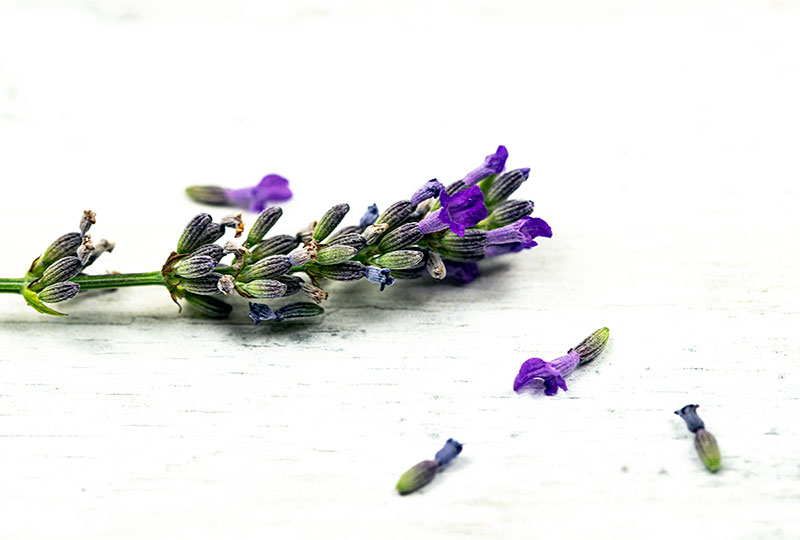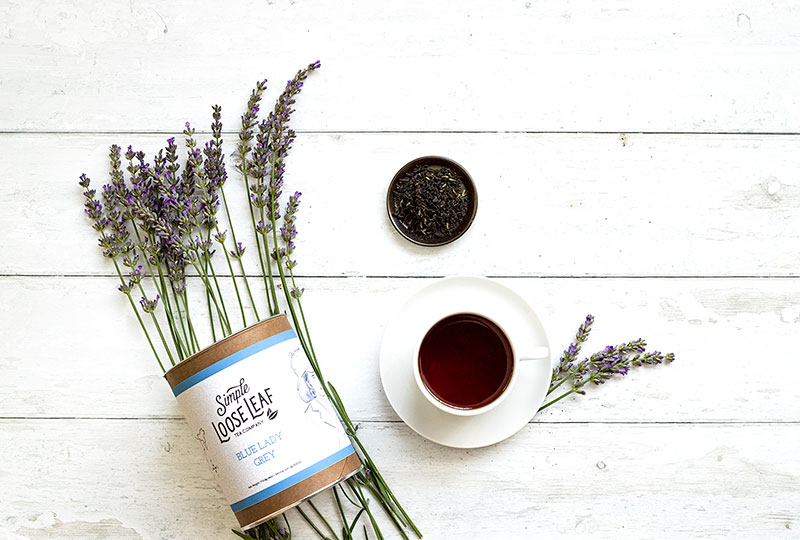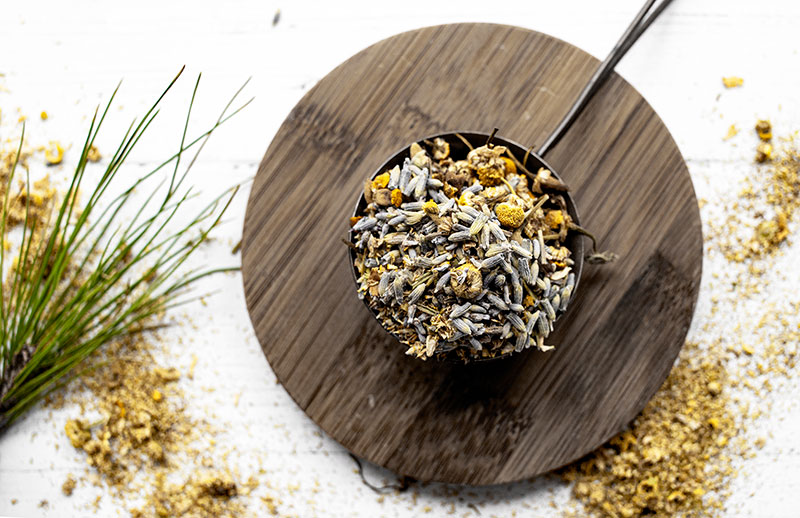Lavender Tea Benefits for Health
This post may contain affiliate links. Simple Loose Leaf is a participant in the Amazon Associates Program, an affiliate advertising program designed to provide a means for sites to earn advertising fees by linking to Amazon.com. Lavender is one of the most beautiful plants in the world, with one of the most beautiful scents too. Relaxing, sweet floral scent is what makes it extremely popular around the world. Because of its versatility, it’s one of the best garden plants to have and to enjoy when you need a bit of beauty and calmness in your life. Learn about the benefits of lavender tea and how to brew a cup of this delicious floral delight.
What is lavender?
Lavender is a flowering shrub, widely popular in Mediterranean countries, but grown all around the world. It’s used for making fragrances, soaps, different skin-care products, essential oils, keeping the moths away and for cooking. Although leaves are edible too, flowers are the most interesting and valuable part of the lavender plant. They are used fresh and dried and for making lavender essential oils and lavender extracts. There are many types of lavender. The most popular and widely used ones are:- Lavandula angustifolia or the common or English lavender
- Lavandula stoechas or the Spanish or French lavender
- Lavandula latifolia or the Portuguese lavender and
- Lavandin or Lavandula intermedia, a hybrid cross between English and Portuguese lavender[1]
Lavender belongs to the Lamiaceae botanical family, same as mint and sage.

Fresh lavender flowers
Although delicious, lavender tea is not as widely consumed as other herbal teas. When prepared pure, lavender can have a very strong flavor, sometimes even bitter. It adds a comforting floral note to many plants or real teas in tea blends. If you love the scent of lavender, you will likely love lavender tea too. For cooking and drinking the most commonly used lavenders are the English lavender and Lavandin. English lavender usually has the sweetest taste, which makes it idea for making tea.Health benefits of lavender tea
Traditionally lavender has not only been used as a home remedy, but as a medicine in hospitals too. It’s one of the most powerful herbal „medicines“ with a wide range of potential benefits. Lavender can be used as tea, essential oil, or as an ingredient in other products. It can be used topically, orally and for inhalation. The effects of lavender oil in arometherapy are already widely researched. It’s consider safe, but side effects are still possible, especially if you are using essential oils of the unknown origin. Every oil will have a different chemical composition that will depend on the plant and extraction technique, and some may cause ellergic reactions.
Blue Lady Grey tea with lavender flowers
Today, lavender is primarily used for relaxation and wound healing because of the anti inflammatory property and the ability to boost collagen production. It doesn’t contain caffeine and is suitable for any time of the day. However, some lavender tea blends may contain caffeine if they are blended with real tea, such as black or green.-
Stabilising the mood and nervous system
Lavender is very often used as a natural way to stabilise the mood, relieve anxiety and help with depression. Linalool, a chemical compound in lavender essential oil may be responsible for reducing anxiety[2] and providing a calming effect.[3] It’s present in other plants from the Lamiaceae botanical family, and may help with the Alzheimer’s disease[4]. Studies suggest that drinking lavender tea is both safe and effective for elderly people too[5]. -
Wound healing
Lavender has been used for healing burns, cuts and different wounds for centuries. Studies showed that topically lavender oil may help with fresh wound healing by increasing the production of collagen[6]. This essential oil is one of the rare oils that can be applied to the skin undilluted. Regardless of the potential benefit, don't try to treat any open wounds or burns without consulting your doctor first. -
Relieving pain and migraines
Inhalation of the lavender essential oil may help with different types of pain. Studies showed that the 15 minutes long inhalation may help with treating acute headaches and migraines.[7] Long-term inhalation or a massage with lavender based oil may reduce the menstrual pain,[8] chronic neck pain and postoperative pain[9]. -
Improving sleep
Maybe you’ve noticed that many pillow mists and sleep balms contain lavender as the only or the main ingredients. The scent of lavender is tightly related to the feeling of relaxation. Indeed, inhaling lavender essential oil may have small to moderate effect on sleep quality[10] and may even improve the quality of the "awake" part of the day too[11]. -
Promoting hair growth
Another unique benefit of lavender essential oil is promoting hair growth[12]. Even though more studies are needed to confirm lavender’s potential in regrowing new hair, it’s considered safe. Together with some other essential oils such as mentha piperita and rosemary, it could prove invaluable in hair loss treatments. -
Balancing immune system
Studies showed that lavender may help balance our overall immune system because of its anti inflammatory property[13].
Chamomile Lavender herbal tea blend
How to make lavender tea
You can make lavender tea with both fresh and dried flowers. If you are using a home-grown lavender, make sure to find out it's safe for consumption. The best time to harvest lavender flowers is right before they start to open. They will have the highest fragrance and the best taste. Alternatively buy dried lavender flowers marked safe for culinary use. Bring fresh spring water to a boil. Add about one teaspoon of flowers per cup of water and steep for 5-10 minutes in boiling water. If you are not used to the intense scent and flavor of lavender tea, steep it for 5 minutes. Depending on the type you are using, it will have a more sweet or bitter flavor. Honey goes well with lavender tea and it’s a healthier option than sugar. If you find the taste too strong, blend it with other herbs or flowers. It blends amazingly well with black tea, chamomile and mint.Disclaimer: This article is for informational purposes only. It’s not intended to replace medical advice, diagnosis or treatment. Every person is different and may react to different herbs and teas differently. Never use teas or herbs to treat serious medical conditions on your own. Always seek professional medical advice before choosing home remedies.
References:
[1] https://www.ncbi.nlm.nih.gov/pmc/articles/PMC3612440/ [2] https://www.sciencedaily.com/releases/2019/12/191218153447.htm [3] https://journals.sagepub.com/doi/pdf/10.1177/1934578X0800300727 [4] https://journals.sagepub.com/doi/pdf/10.1177/1934578X0800300727 [5] https://pubmed.ncbi.nlm.nih.gov/32444033/ [6] https://www.ncbi.nlm.nih.gov/pmc/articles/PMC4880962/ [7] https://www.researchgate.net/publication/224769723_Lavender_Essential_Oil_in_the_Treatment_of_Migraine_Headache_A_Placebo-Controlled_Clinical_Trial [8] https://www.ncbi.nlm.nih.gov/pmc/articles/PMC5405632/ [9] https://www.ncbi.nlm.nih.gov/pmc/articles/PMC5192342/ [10] https://www.sciencedirect.com/science/article/abs/pii/S1876382012010700 [11] https://www.ncbi.nlm.nih.gov/pmc/articles/PMC3612440/ [12] https://www.ncbi.nlm.nih.gov/pmc/articles/PMC4843973/ [13] https://www.ncbi.nlm.nih.gov/pmc/articles/PMC6943609/
More from:
SLL





Leave a comment